Financial Decision Making Report: Analyzing SKANSA PLC's Financials
VerifiedAdded on 2023/01/05
|11
|3544
|53
Report
AI Summary
This report provides a comprehensive analysis of financial decision-making within SKANSA PLC. It begins by outlining the importance of accounting and finance functions, detailing how these departments contribute to the company's profitability and strategic planning. The report then delves into the roles and responsibilities of various accounting and finance positions, including financial management, financial systems, accounts payable and receivable, payroll, and financial reporting. The analysis extends to key personnel such as CFOs, financial controllers, and accounting managers. The second part of the report focuses on ratio analysis, calculating and interpreting ratios such as Return on Capital Employed (ROCE), Net Profit Margin, Average Receivable Days, and Average Payable Days for SKANSA PLC for 2018 and 2019. The report concludes with an assessment of SKANSA PLC's financial performance based on these ratios and highlights the significance of these financial metrics in evaluating the company's financial health and decision-making processes. The report offers insights into SKANSA PLC's financial strategies and performance.

FINANCIAL DECISION
MAKING
MAKING
Paraphrase This Document
Need a fresh take? Get an instant paraphrase of this document with our AI Paraphraser
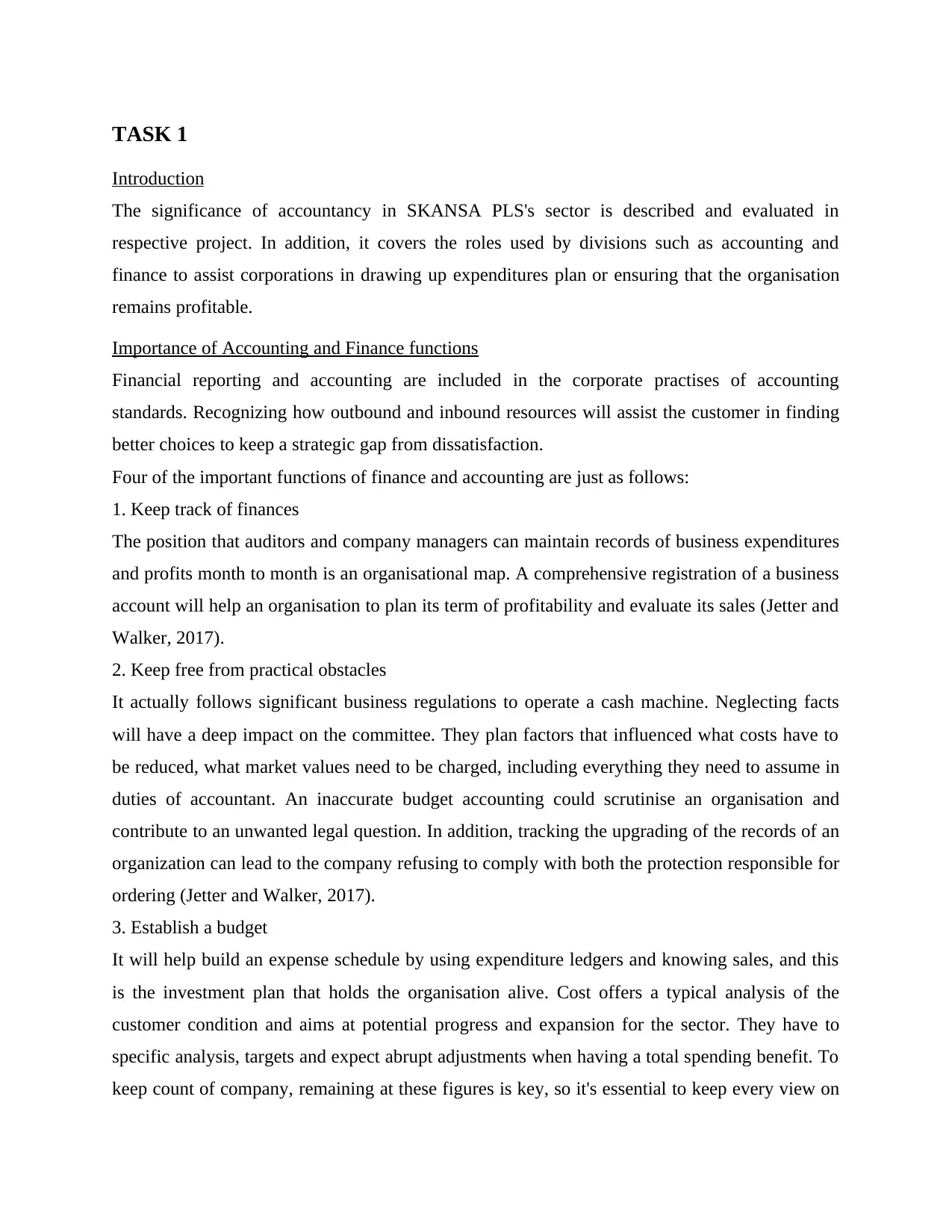
TASK 1
Introduction
The significance of accountancy in SKANSA PLS's sector is described and evaluated in
respective project. In addition, it covers the roles used by divisions such as accounting and
finance to assist corporations in drawing up expenditures plan or ensuring that the organisation
remains profitable.
Importance of Accounting and Finance functions
Financial reporting and accounting are included in the corporate practises of accounting
standards. Recognizing how outbound and inbound resources will assist the customer in finding
better choices to keep a strategic gap from dissatisfaction.
Four of the important functions of finance and accounting are just as follows:
1. Keep track of finances
The position that auditors and company managers can maintain records of business expenditures
and profits month to month is an organisational map. A comprehensive registration of a business
account will help an organisation to plan its term of profitability and evaluate its sales (Jetter and
Walker, 2017).
2. Keep free from practical obstacles
It actually follows significant business regulations to operate a cash machine. Neglecting facts
will have a deep impact on the committee. They plan factors that influenced what costs have to
be reduced, what market values need to be charged, including everything they need to assume in
duties of accountant. An inaccurate budget accounting could scrutinise an organisation and
contribute to an unwanted legal question. In addition, tracking the upgrading of the records of an
organization can lead to the company refusing to comply with both the protection responsible for
ordering (Jetter and Walker, 2017).
3. Establish a budget
It will help build an expense schedule by using expenditure ledgers and knowing sales, and this
is the investment plan that holds the organisation alive. Cost offers a typical analysis of the
customer condition and aims at potential progress and expansion for the sector. They have to
specific analysis, targets and expect abrupt adjustments when having a total spending benefit. To
keep count of company, remaining at these figures is key, so it's essential to keep every view on
Introduction
The significance of accountancy in SKANSA PLS's sector is described and evaluated in
respective project. In addition, it covers the roles used by divisions such as accounting and
finance to assist corporations in drawing up expenditures plan or ensuring that the organisation
remains profitable.
Importance of Accounting and Finance functions
Financial reporting and accounting are included in the corporate practises of accounting
standards. Recognizing how outbound and inbound resources will assist the customer in finding
better choices to keep a strategic gap from dissatisfaction.
Four of the important functions of finance and accounting are just as follows:
1. Keep track of finances
The position that auditors and company managers can maintain records of business expenditures
and profits month to month is an organisational map. A comprehensive registration of a business
account will help an organisation to plan its term of profitability and evaluate its sales (Jetter and
Walker, 2017).
2. Keep free from practical obstacles
It actually follows significant business regulations to operate a cash machine. Neglecting facts
will have a deep impact on the committee. They plan factors that influenced what costs have to
be reduced, what market values need to be charged, including everything they need to assume in
duties of accountant. An inaccurate budget accounting could scrutinise an organisation and
contribute to an unwanted legal question. In addition, tracking the upgrading of the records of an
organization can lead to the company refusing to comply with both the protection responsible for
ordering (Jetter and Walker, 2017).
3. Establish a budget
It will help build an expense schedule by using expenditure ledgers and knowing sales, and this
is the investment plan that holds the organisation alive. Cost offers a typical analysis of the
customer condition and aims at potential progress and expansion for the sector. They have to
specific analysis, targets and expect abrupt adjustments when having a total spending benefit. To
keep count of company, remaining at these figures is key, so it's essential to keep every view on
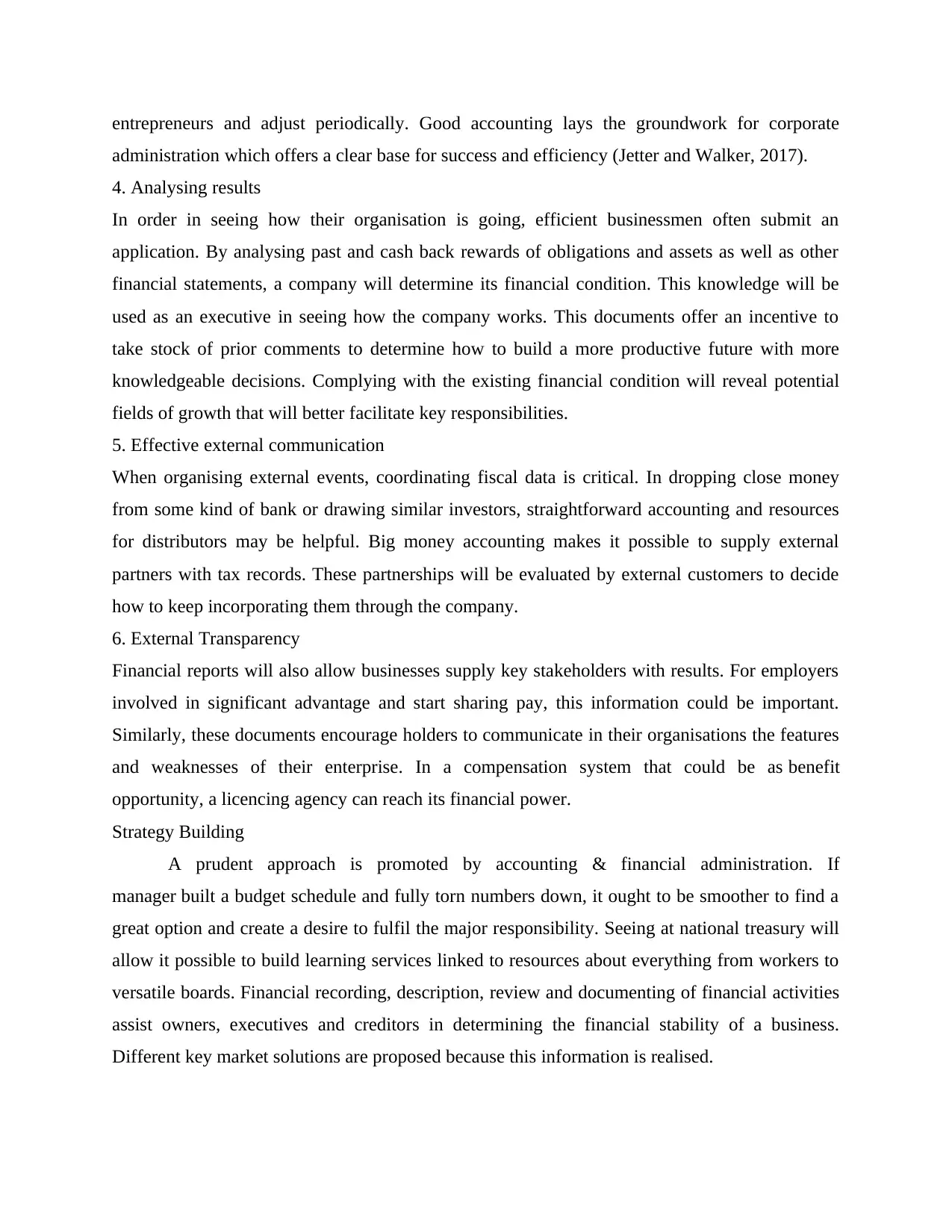
entrepreneurs and adjust periodically. Good accounting lays the groundwork for corporate
administration which offers a clear base for success and efficiency (Jetter and Walker, 2017).
4. Analysing results
In order in seeing how their organisation is going, efficient businessmen often submit an
application. By analysing past and cash back rewards of obligations and assets as well as other
financial statements, a company will determine its financial condition. This knowledge will be
used as an executive in seeing how the company works. This documents offer an incentive to
take stock of prior comments to determine how to build a more productive future with more
knowledgeable decisions. Complying with the existing financial condition will reveal potential
fields of growth that will better facilitate key responsibilities.
5. Effective external communication
When organising external events, coordinating fiscal data is critical. In dropping close money
from some kind of bank or drawing similar investors, straightforward accounting and resources
for distributors may be helpful. Big money accounting makes it possible to supply external
partners with tax records. These partnerships will be evaluated by external customers to decide
how to keep incorporating them through the company.
6. External Transparency
Financial reports will also allow businesses supply key stakeholders with results. For employers
involved in significant advantage and start sharing pay, this information could be important.
Similarly, these documents encourage holders to communicate in their organisations the features
and weaknesses of their enterprise. In a compensation system that could be as benefit
opportunity, a licencing agency can reach its financial power.
Strategy Building
A prudent approach is promoted by accounting & financial administration. If
manager built a budget schedule and fully torn numbers down, it ought to be smoother to find a
great option and create a desire to fulfil the major responsibility. Seeing at national treasury will
allow it possible to build learning services linked to resources about everything from workers to
versatile boards. Financial recording, description, review and documenting of financial activities
assist owners, executives and creditors in determining the financial stability of a business.
Different key market solutions are proposed because this information is realised.
administration which offers a clear base for success and efficiency (Jetter and Walker, 2017).
4. Analysing results
In order in seeing how their organisation is going, efficient businessmen often submit an
application. By analysing past and cash back rewards of obligations and assets as well as other
financial statements, a company will determine its financial condition. This knowledge will be
used as an executive in seeing how the company works. This documents offer an incentive to
take stock of prior comments to determine how to build a more productive future with more
knowledgeable decisions. Complying with the existing financial condition will reveal potential
fields of growth that will better facilitate key responsibilities.
5. Effective external communication
When organising external events, coordinating fiscal data is critical. In dropping close money
from some kind of bank or drawing similar investors, straightforward accounting and resources
for distributors may be helpful. Big money accounting makes it possible to supply external
partners with tax records. These partnerships will be evaluated by external customers to decide
how to keep incorporating them through the company.
6. External Transparency
Financial reports will also allow businesses supply key stakeholders with results. For employers
involved in significant advantage and start sharing pay, this information could be important.
Similarly, these documents encourage holders to communicate in their organisations the features
and weaknesses of their enterprise. In a compensation system that could be as benefit
opportunity, a licencing agency can reach its financial power.
Strategy Building
A prudent approach is promoted by accounting & financial administration. If
manager built a budget schedule and fully torn numbers down, it ought to be smoother to find a
great option and create a desire to fulfil the major responsibility. Seeing at national treasury will
allow it possible to build learning services linked to resources about everything from workers to
versatile boards. Financial recording, description, review and documenting of financial activities
assist owners, executives and creditors in determining the financial stability of a business.
Different key market solutions are proposed because this information is realised.
⊘ This is a preview!⊘
Do you want full access?
Subscribe today to unlock all pages.

Trusted by 1+ million students worldwide
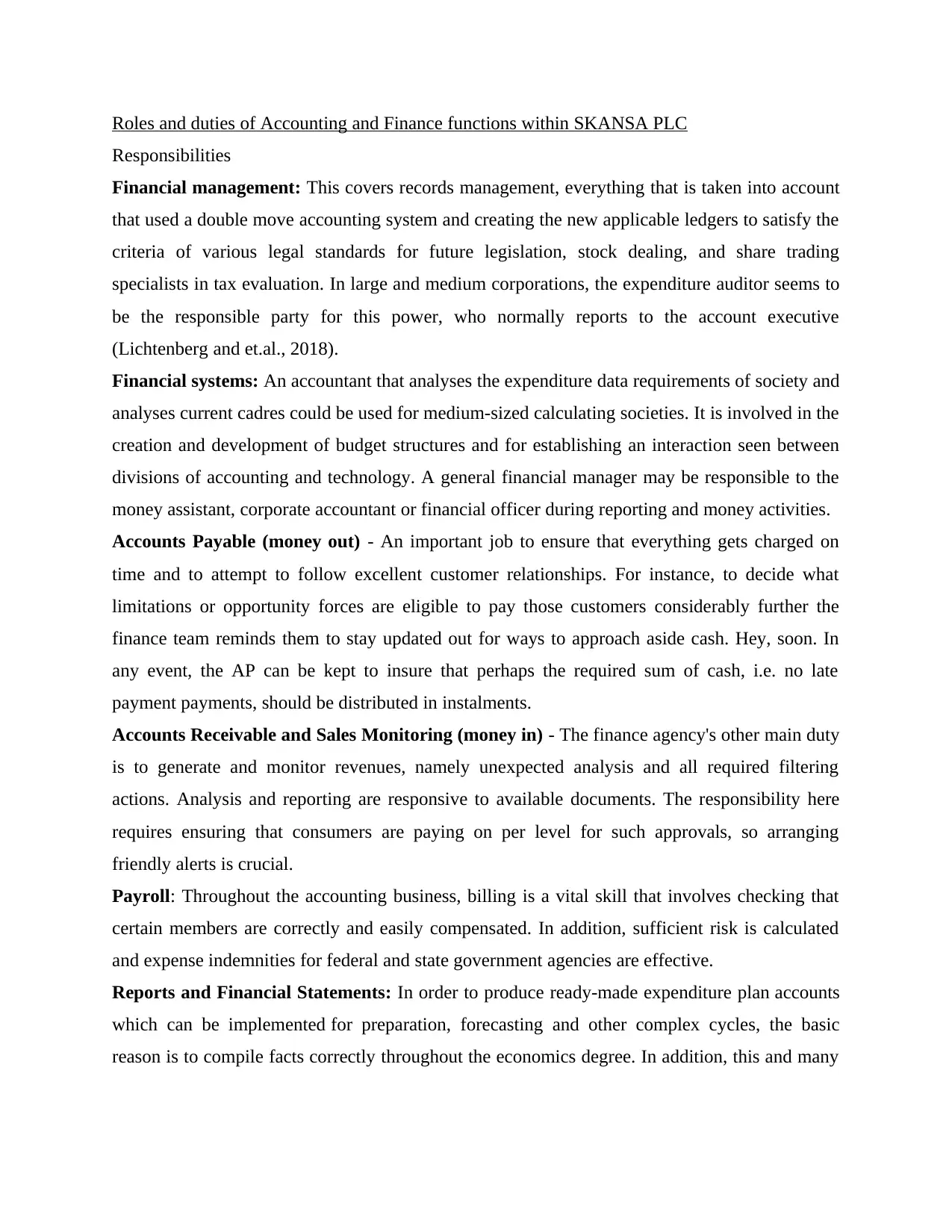
Roles and duties of Accounting and Finance functions within SKANSA PLC
Responsibilities
Financial management: This covers records management, everything that is taken into account
that used a double move accounting system and creating the new applicable ledgers to satisfy the
criteria of various legal standards for future legislation, stock dealing, and share trading
specialists in tax evaluation. In large and medium corporations, the expenditure auditor seems to
be the responsible party for this power, who normally reports to the account executive
(Lichtenberg and et.al., 2018).
Financial systems: An accountant that analyses the expenditure data requirements of society and
analyses current cadres could be used for medium-sized calculating societies. It is involved in the
creation and development of budget structures and for establishing an interaction seen between
divisions of accounting and technology. A general financial manager may be responsible to the
money assistant, corporate accountant or financial officer during reporting and money activities.
Accounts Payable (money out) - An important job to ensure that everything gets charged on
time and to attempt to follow excellent customer relationships. For instance, to decide what
limitations or opportunity forces are eligible to pay those customers considerably further the
finance team reminds them to stay updated out for ways to approach aside cash. Hey, soon. In
any event, the AP can be kept to insure that perhaps the required sum of cash, i.e. no late
payment payments, should be distributed in instalments.
Accounts Receivable and Sales Monitoring (money in) - The finance agency's other main duty
is to generate and monitor revenues, namely unexpected analysis and all required filtering
actions. Analysis and reporting are responsive to available documents. The responsibility here
requires ensuring that consumers are paying on per level for such approvals, so arranging
friendly alerts is crucial.
Payroll: Throughout the accounting business, billing is a vital skill that involves checking that
certain members are correctly and easily compensated. In addition, sufficient risk is calculated
and expense indemnities for federal and state government agencies are effective.
Reports and Financial Statements: In order to produce ready-made expenditure plan accounts
which can be implemented for preparation, forecasting and other complex cycles, the basic
reason is to compile facts correctly throughout the economics degree. In addition, this and many
Responsibilities
Financial management: This covers records management, everything that is taken into account
that used a double move accounting system and creating the new applicable ledgers to satisfy the
criteria of various legal standards for future legislation, stock dealing, and share trading
specialists in tax evaluation. In large and medium corporations, the expenditure auditor seems to
be the responsible party for this power, who normally reports to the account executive
(Lichtenberg and et.al., 2018).
Financial systems: An accountant that analyses the expenditure data requirements of society and
analyses current cadres could be used for medium-sized calculating societies. It is involved in the
creation and development of budget structures and for establishing an interaction seen between
divisions of accounting and technology. A general financial manager may be responsible to the
money assistant, corporate accountant or financial officer during reporting and money activities.
Accounts Payable (money out) - An important job to ensure that everything gets charged on
time and to attempt to follow excellent customer relationships. For instance, to decide what
limitations or opportunity forces are eligible to pay those customers considerably further the
finance team reminds them to stay updated out for ways to approach aside cash. Hey, soon. In
any event, the AP can be kept to insure that perhaps the required sum of cash, i.e. no late
payment payments, should be distributed in instalments.
Accounts Receivable and Sales Monitoring (money in) - The finance agency's other main duty
is to generate and monitor revenues, namely unexpected analysis and all required filtering
actions. Analysis and reporting are responsive to available documents. The responsibility here
requires ensuring that consumers are paying on per level for such approvals, so arranging
friendly alerts is crucial.
Payroll: Throughout the accounting business, billing is a vital skill that involves checking that
certain members are correctly and easily compensated. In addition, sufficient risk is calculated
and expense indemnities for federal and state government agencies are effective.
Reports and Financial Statements: In order to produce ready-made expenditure plan accounts
which can be implemented for preparation, forecasting and other complex cycles, the basic
reason is to compile facts correctly throughout the economics degree. In addition, this and many
Paraphrase This Document
Need a fresh take? Get an instant paraphrase of this document with our AI Paraphraser
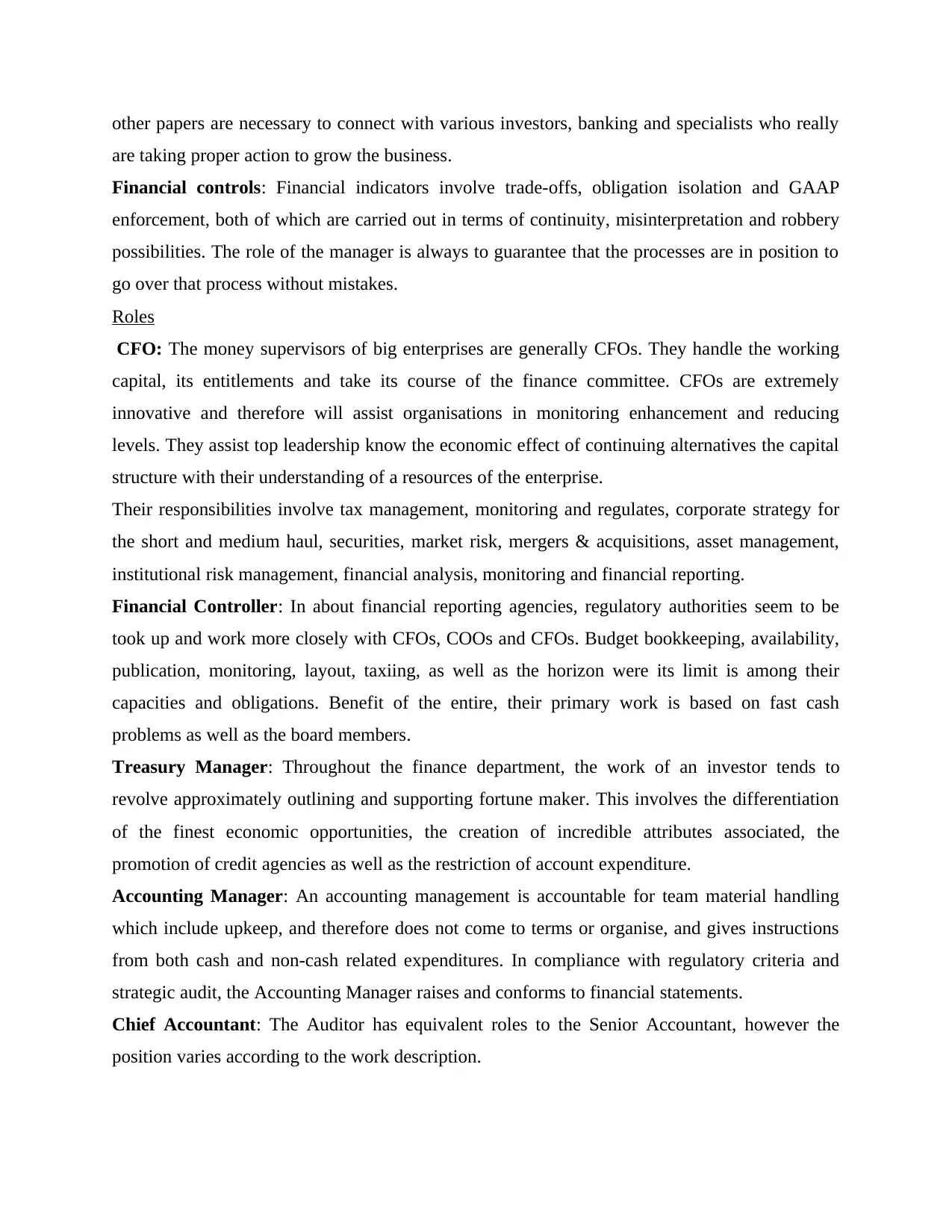
other papers are necessary to connect with various investors, banking and specialists who really
are taking proper action to grow the business.
Financial controls: Financial indicators involve trade-offs, obligation isolation and GAAP
enforcement, both of which are carried out in terms of continuity, misinterpretation and robbery
possibilities. The role of the manager is always to guarantee that the processes are in position to
go over that process without mistakes.
Roles
CFO: The money supervisors of big enterprises are generally CFOs. They handle the working
capital, its entitlements and take its course of the finance committee. CFOs are extremely
innovative and therefore will assist organisations in monitoring enhancement and reducing
levels. They assist top leadership know the economic effect of continuing alternatives the capital
structure with their understanding of a resources of the enterprise.
Their responsibilities involve tax management, monitoring and regulates, corporate strategy for
the short and medium haul, securities, market risk, mergers & acquisitions, asset management,
institutional risk management, financial analysis, monitoring and financial reporting.
Financial Controller: In about financial reporting agencies, regulatory authorities seem to be
took up and work more closely with CFOs, COOs and CFOs. Budget bookkeeping, availability,
publication, monitoring, layout, taxiing, as well as the horizon were its limit is among their
capacities and obligations. Benefit of the entire, their primary work is based on fast cash
problems as well as the board members.
Treasury Manager: Throughout the finance department, the work of an investor tends to
revolve approximately outlining and supporting fortune maker. This involves the differentiation
of the finest economic opportunities, the creation of incredible attributes associated, the
promotion of credit agencies as well as the restriction of account expenditure.
Accounting Manager: An accounting management is accountable for team material handling
which include upkeep, and therefore does not come to terms or organise, and gives instructions
from both cash and non-cash related expenditures. In compliance with regulatory criteria and
strategic audit, the Accounting Manager raises and conforms to financial statements.
Chief Accountant: The Auditor has equivalent roles to the Senior Accountant, however the
position varies according to the work description.
are taking proper action to grow the business.
Financial controls: Financial indicators involve trade-offs, obligation isolation and GAAP
enforcement, both of which are carried out in terms of continuity, misinterpretation and robbery
possibilities. The role of the manager is always to guarantee that the processes are in position to
go over that process without mistakes.
Roles
CFO: The money supervisors of big enterprises are generally CFOs. They handle the working
capital, its entitlements and take its course of the finance committee. CFOs are extremely
innovative and therefore will assist organisations in monitoring enhancement and reducing
levels. They assist top leadership know the economic effect of continuing alternatives the capital
structure with their understanding of a resources of the enterprise.
Their responsibilities involve tax management, monitoring and regulates, corporate strategy for
the short and medium haul, securities, market risk, mergers & acquisitions, asset management,
institutional risk management, financial analysis, monitoring and financial reporting.
Financial Controller: In about financial reporting agencies, regulatory authorities seem to be
took up and work more closely with CFOs, COOs and CFOs. Budget bookkeeping, availability,
publication, monitoring, layout, taxiing, as well as the horizon were its limit is among their
capacities and obligations. Benefit of the entire, their primary work is based on fast cash
problems as well as the board members.
Treasury Manager: Throughout the finance department, the work of an investor tends to
revolve approximately outlining and supporting fortune maker. This involves the differentiation
of the finest economic opportunities, the creation of incredible attributes associated, the
promotion of credit agencies as well as the restriction of account expenditure.
Accounting Manager: An accounting management is accountable for team material handling
which include upkeep, and therefore does not come to terms or organise, and gives instructions
from both cash and non-cash related expenditures. In compliance with regulatory criteria and
strategic audit, the Accounting Manager raises and conforms to financial statements.
Chief Accountant: The Auditor has equivalent roles to the Senior Accountant, however the
position varies according to the work description.
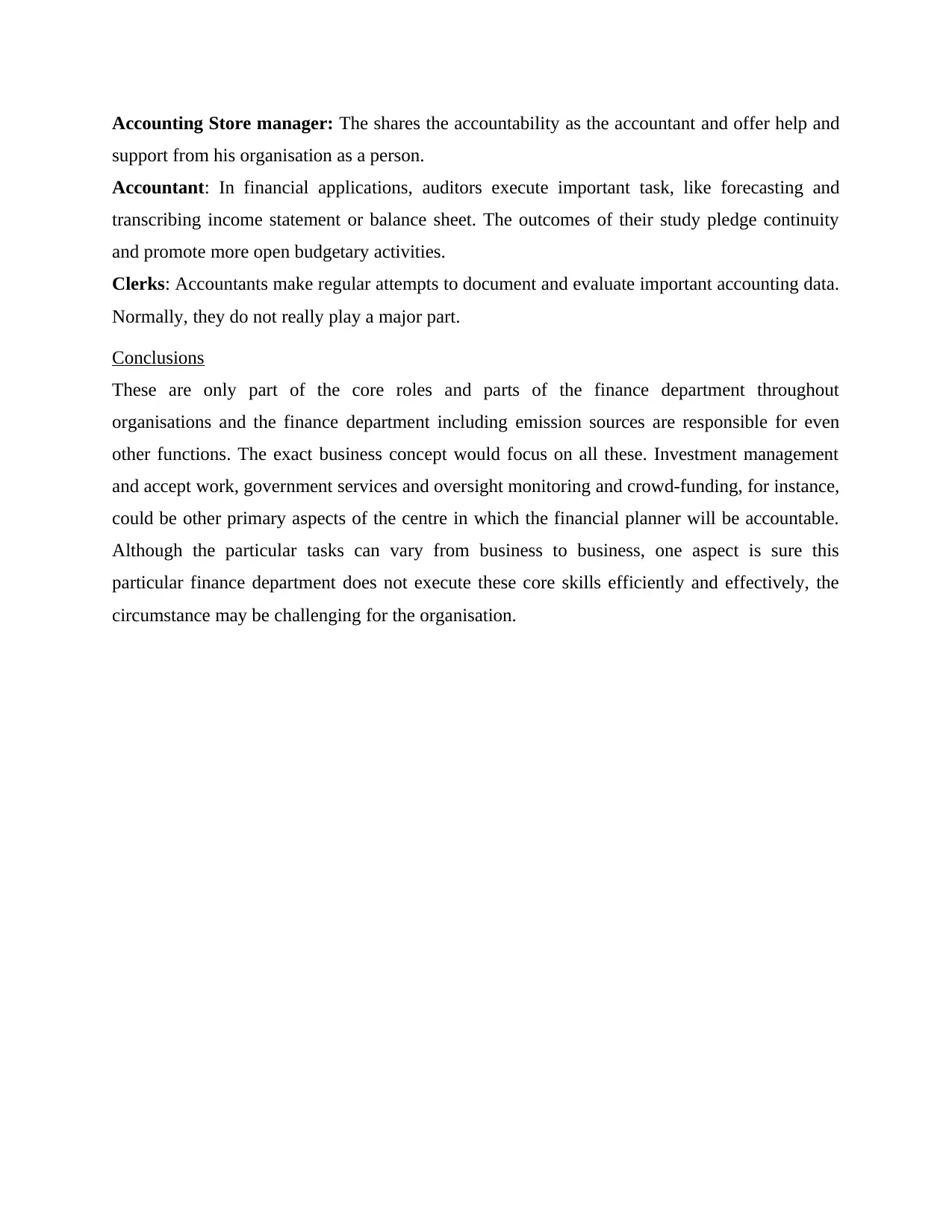
Accounting Store manager: The shares the accountability as the accountant and offer help and
support from his organisation as a person.
Accountant: In financial applications, auditors execute important task, like forecasting and
transcribing income statement or balance sheet. The outcomes of their study pledge continuity
and promote more open budgetary activities.
Clerks: Accountants make regular attempts to document and evaluate important accounting data.
Normally, they do not really play a major part.
Conclusions
These are only part of the core roles and parts of the finance department throughout
organisations and the finance department including emission sources are responsible for even
other functions. The exact business concept would focus on all these. Investment management
and accept work, government services and oversight monitoring and crowd-funding, for instance,
could be other primary aspects of the centre in which the financial planner will be accountable.
Although the particular tasks can vary from business to business, one aspect is sure this
particular finance department does not execute these core skills efficiently and effectively, the
circumstance may be challenging for the organisation.
support from his organisation as a person.
Accountant: In financial applications, auditors execute important task, like forecasting and
transcribing income statement or balance sheet. The outcomes of their study pledge continuity
and promote more open budgetary activities.
Clerks: Accountants make regular attempts to document and evaluate important accounting data.
Normally, they do not really play a major part.
Conclusions
These are only part of the core roles and parts of the finance department throughout
organisations and the finance department including emission sources are responsible for even
other functions. The exact business concept would focus on all these. Investment management
and accept work, government services and oversight monitoring and crowd-funding, for instance,
could be other primary aspects of the centre in which the financial planner will be accountable.
Although the particular tasks can vary from business to business, one aspect is sure this
particular finance department does not execute these core skills efficiently and effectively, the
circumstance may be challenging for the organisation.
⊘ This is a preview!⊘
Do you want full access?
Subscribe today to unlock all pages.

Trusted by 1+ million students worldwide
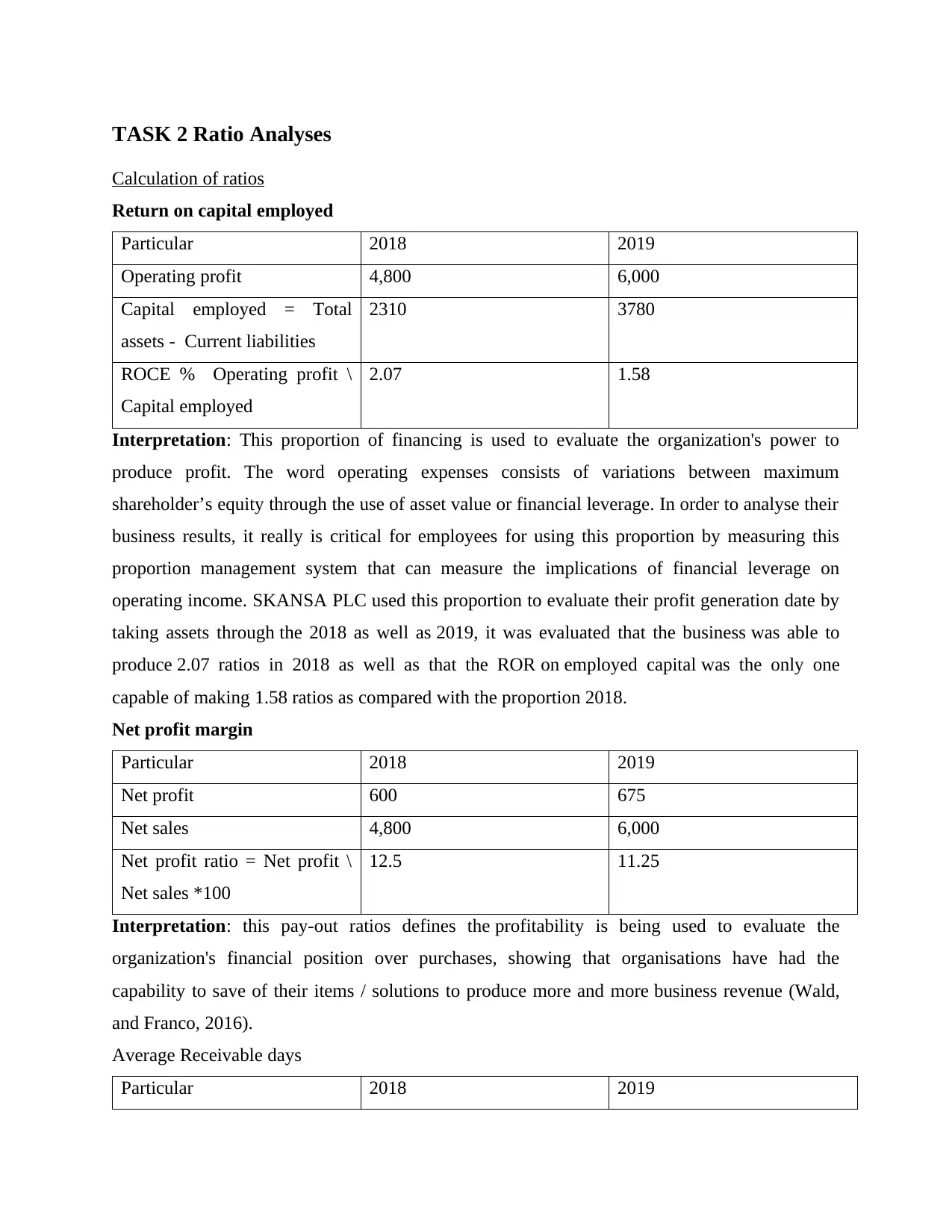
TASK 2 Ratio Analyses
Calculation of ratios
Return on capital employed
Particular 2018 2019
Operating profit 4,800 6,000
Capital employed = Total
assets - Current liabilities
2310 3780
ROCE % Operating profit \
Capital employed
2.07 1.58
Interpretation: This proportion of financing is used to evaluate the organization's power to
produce profit. The word operating expenses consists of variations between maximum
shareholder’s equity through the use of asset value or financial leverage. In order to analyse their
business results, it really is critical for employees for using this proportion by measuring this
proportion management system that can measure the implications of financial leverage on
operating income. SKANSA PLC used this proportion to evaluate their profit generation date by
taking assets through the 2018 as well as 2019, it was evaluated that the business was able to
produce 2.07 ratios in 2018 as well as that the ROR on employed capital was the only one
capable of making 1.58 ratios as compared with the proportion 2018.
Net profit margin
Particular 2018 2019
Net profit 600 675
Net sales 4,800 6,000
Net profit ratio = Net profit \
Net sales *100
12.5 11.25
Interpretation: this pay-out ratios defines the profitability is being used to evaluate the
organization's financial position over purchases, showing that organisations have had the
capability to save of their items / solutions to produce more and more business revenue (Wald,
and Franco, 2016).
Average Receivable days
Particular 2018 2019
Calculation of ratios
Return on capital employed
Particular 2018 2019
Operating profit 4,800 6,000
Capital employed = Total
assets - Current liabilities
2310 3780
ROCE % Operating profit \
Capital employed
2.07 1.58
Interpretation: This proportion of financing is used to evaluate the organization's power to
produce profit. The word operating expenses consists of variations between maximum
shareholder’s equity through the use of asset value or financial leverage. In order to analyse their
business results, it really is critical for employees for using this proportion by measuring this
proportion management system that can measure the implications of financial leverage on
operating income. SKANSA PLC used this proportion to evaluate their profit generation date by
taking assets through the 2018 as well as 2019, it was evaluated that the business was able to
produce 2.07 ratios in 2018 as well as that the ROR on employed capital was the only one
capable of making 1.58 ratios as compared with the proportion 2018.
Net profit margin
Particular 2018 2019
Net profit 600 675
Net sales 4,800 6,000
Net profit ratio = Net profit \
Net sales *100
12.5 11.25
Interpretation: this pay-out ratios defines the profitability is being used to evaluate the
organization's financial position over purchases, showing that organisations have had the
capability to save of their items / solutions to produce more and more business revenue (Wald,
and Franco, 2016).
Average Receivable days
Particular 2018 2019
Paraphrase This Document
Need a fresh take? Get an instant paraphrase of this document with our AI Paraphraser
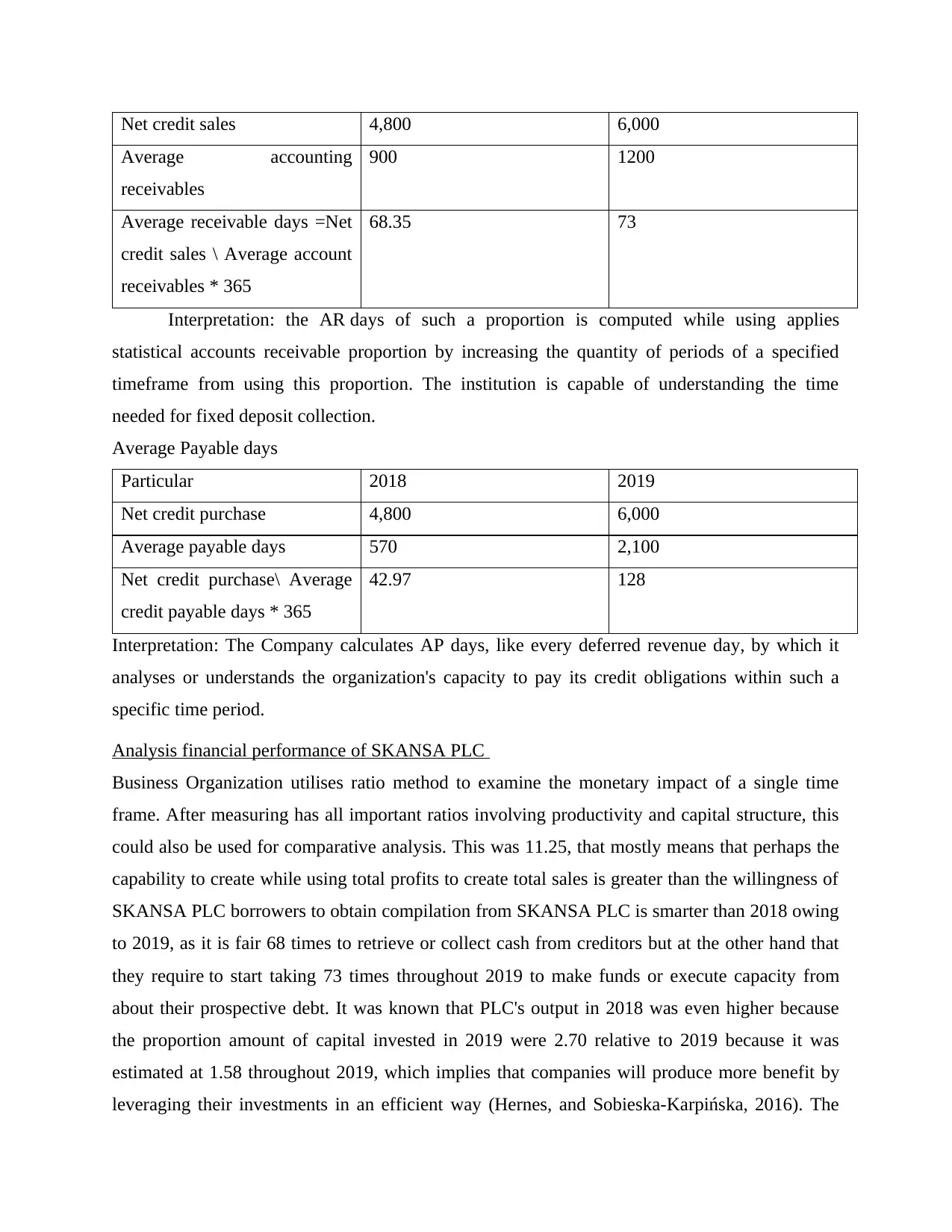
Net credit sales 4,800 6,000
Average accounting
receivables
900 1200
Average receivable days =Net
credit sales \ Average account
receivables * 365
68.35 73
Interpretation: the AR days of such a proportion is computed while using applies
statistical accounts receivable proportion by increasing the quantity of periods of a specified
timeframe from using this proportion. The institution is capable of understanding the time
needed for fixed deposit collection.
Average Payable days
Particular 2018 2019
Net credit purchase 4,800 6,000
Average payable days 570 2,100
Net credit purchase\ Average
credit payable days * 365
42.97 128
Interpretation: The Company calculates AP days, like every deferred revenue day, by which it
analyses or understands the organization's capacity to pay its credit obligations within such a
specific time period.
Analysis financial performance of SKANSA PLC
Business Organization utilises ratio method to examine the monetary impact of a single time
frame. After measuring has all important ratios involving productivity and capital structure, this
could also be used for comparative analysis. This was 11.25, that mostly means that perhaps the
capability to create while using total profits to create total sales is greater than the willingness of
SKANSA PLC borrowers to obtain compilation from SKANSA PLC is smarter than 2018 owing
to 2019, as it is fair 68 times to retrieve or collect cash from creditors but at the other hand that
they require to start taking 73 times throughout 2019 to make funds or execute capacity from
about their prospective debt. It was known that PLC's output in 2018 was even higher because
the proportion amount of capital invested in 2019 were 2.70 relative to 2019 because it was
estimated at 1.58 throughout 2019, which implies that companies will produce more benefit by
leveraging their investments in an efficient way (Hernes, and Sobieska-Karpińska, 2016). The
Average accounting
receivables
900 1200
Average receivable days =Net
credit sales \ Average account
receivables * 365
68.35 73
Interpretation: the AR days of such a proportion is computed while using applies
statistical accounts receivable proportion by increasing the quantity of periods of a specified
timeframe from using this proportion. The institution is capable of understanding the time
needed for fixed deposit collection.
Average Payable days
Particular 2018 2019
Net credit purchase 4,800 6,000
Average payable days 570 2,100
Net credit purchase\ Average
credit payable days * 365
42.97 128
Interpretation: The Company calculates AP days, like every deferred revenue day, by which it
analyses or understands the organization's capacity to pay its credit obligations within such a
specific time period.
Analysis financial performance of SKANSA PLC
Business Organization utilises ratio method to examine the monetary impact of a single time
frame. After measuring has all important ratios involving productivity and capital structure, this
could also be used for comparative analysis. This was 11.25, that mostly means that perhaps the
capability to create while using total profits to create total sales is greater than the willingness of
SKANSA PLC borrowers to obtain compilation from SKANSA PLC is smarter than 2018 owing
to 2019, as it is fair 68 times to retrieve or collect cash from creditors but at the other hand that
they require to start taking 73 times throughout 2019 to make funds or execute capacity from
about their prospective debt. It was known that PLC's output in 2018 was even higher because
the proportion amount of capital invested in 2019 were 2.70 relative to 2019 because it was
estimated at 1.58 throughout 2019, which implies that companies will produce more benefit by
leveraging their investments in an efficient way (Hernes, and Sobieska-Karpińska, 2016). The
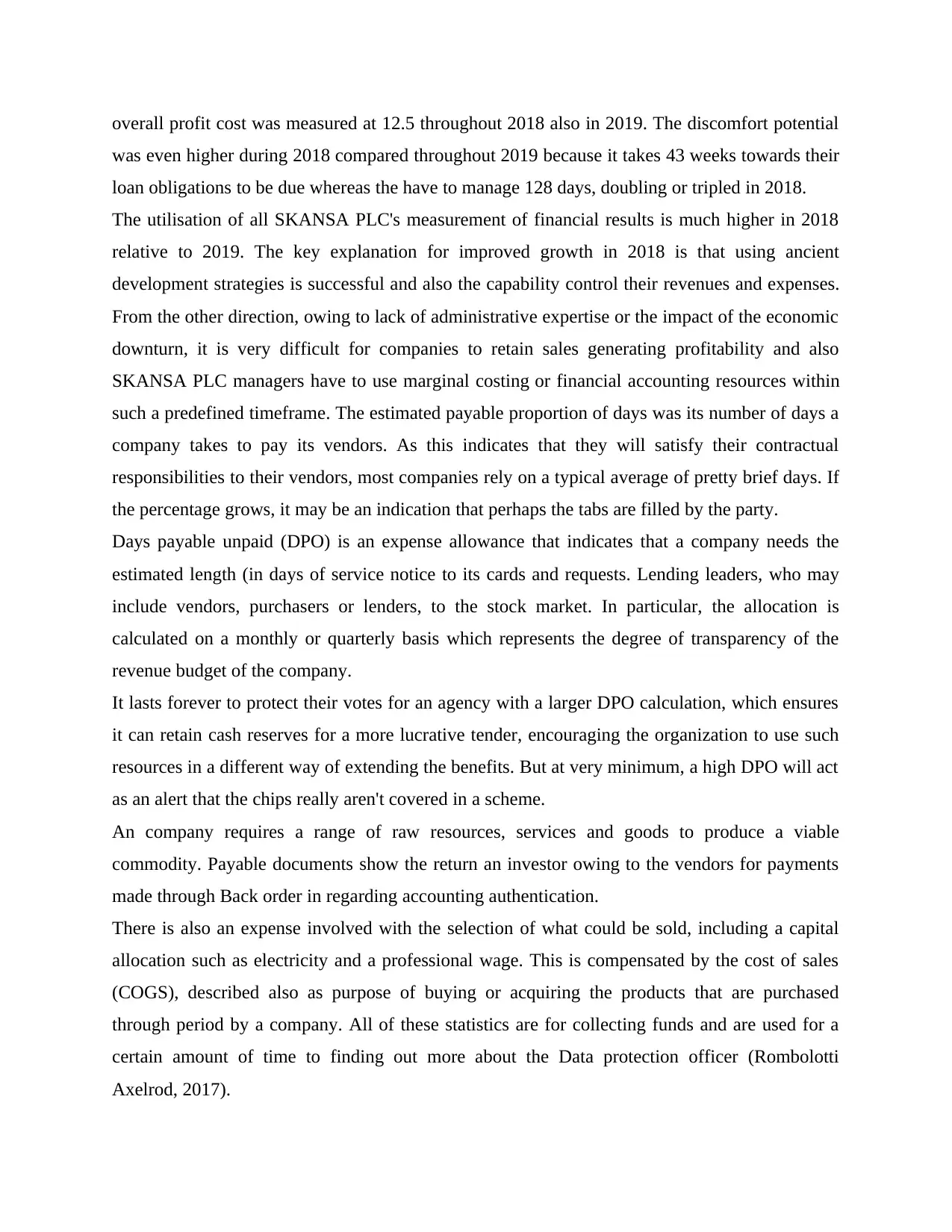
overall profit cost was measured at 12.5 throughout 2018 also in 2019. The discomfort potential
was even higher during 2018 compared throughout 2019 because it takes 43 weeks towards their
loan obligations to be due whereas the have to manage 128 days, doubling or tripled in 2018.
The utilisation of all SKANSA PLC's measurement of financial results is much higher in 2018
relative to 2019. The key explanation for improved growth in 2018 is that using ancient
development strategies is successful and also the capability control their revenues and expenses.
From the other direction, owing to lack of administrative expertise or the impact of the economic
downturn, it is very difficult for companies to retain sales generating profitability and also
SKANSA PLC managers have to use marginal costing or financial accounting resources within
such a predefined timeframe. The estimated payable proportion of days was its number of days a
company takes to pay its vendors. As this indicates that they will satisfy their contractual
responsibilities to their vendors, most companies rely on a typical average of pretty brief days. If
the percentage grows, it may be an indication that perhaps the tabs are filled by the party.
Days payable unpaid (DPO) is an expense allowance that indicates that a company needs the
estimated length (in days of service notice to its cards and requests. Lending leaders, who may
include vendors, purchasers or lenders, to the stock market. In particular, the allocation is
calculated on a monthly or quarterly basis which represents the degree of transparency of the
revenue budget of the company.
It lasts forever to protect their votes for an agency with a larger DPO calculation, which ensures
it can retain cash reserves for a more lucrative tender, encouraging the organization to use such
resources in a different way of extending the benefits. But at very minimum, a high DPO will act
as an alert that the chips really aren't covered in a scheme.
An company requires a range of raw resources, services and goods to produce a viable
commodity. Payable documents show the return an investor owing to the vendors for payments
made through Back order in regarding accounting authentication.
There is also an expense involved with the selection of what could be sold, including a capital
allocation such as electricity and a professional wage. This is compensated by the cost of sales
(COGS), described also as purpose of buying or acquiring the products that are purchased
through period by a company. All of these statistics are for collecting funds and are used for a
certain amount of time to finding out more about the Data protection officer (Rombolotti
Axelrod, 2017).
was even higher during 2018 compared throughout 2019 because it takes 43 weeks towards their
loan obligations to be due whereas the have to manage 128 days, doubling or tripled in 2018.
The utilisation of all SKANSA PLC's measurement of financial results is much higher in 2018
relative to 2019. The key explanation for improved growth in 2018 is that using ancient
development strategies is successful and also the capability control their revenues and expenses.
From the other direction, owing to lack of administrative expertise or the impact of the economic
downturn, it is very difficult for companies to retain sales generating profitability and also
SKANSA PLC managers have to use marginal costing or financial accounting resources within
such a predefined timeframe. The estimated payable proportion of days was its number of days a
company takes to pay its vendors. As this indicates that they will satisfy their contractual
responsibilities to their vendors, most companies rely on a typical average of pretty brief days. If
the percentage grows, it may be an indication that perhaps the tabs are filled by the party.
Days payable unpaid (DPO) is an expense allowance that indicates that a company needs the
estimated length (in days of service notice to its cards and requests. Lending leaders, who may
include vendors, purchasers or lenders, to the stock market. In particular, the allocation is
calculated on a monthly or quarterly basis which represents the degree of transparency of the
revenue budget of the company.
It lasts forever to protect their votes for an agency with a larger DPO calculation, which ensures
it can retain cash reserves for a more lucrative tender, encouraging the organization to use such
resources in a different way of extending the benefits. But at very minimum, a high DPO will act
as an alert that the chips really aren't covered in a scheme.
An company requires a range of raw resources, services and goods to produce a viable
commodity. Payable documents show the return an investor owing to the vendors for payments
made through Back order in regarding accounting authentication.
There is also an expense involved with the selection of what could be sold, including a capital
allocation such as electricity and a professional wage. This is compensated by the cost of sales
(COGS), described also as purpose of buying or acquiring the products that are purchased
through period by a company. All of these statistics are for collecting funds and are used for a
certain amount of time to finding out more about the Data protection officer (Rombolotti
Axelrod, 2017).
⊘ This is a preview!⊘
Do you want full access?
Subscribe today to unlock all pages.

Trusted by 1+ million students worldwide
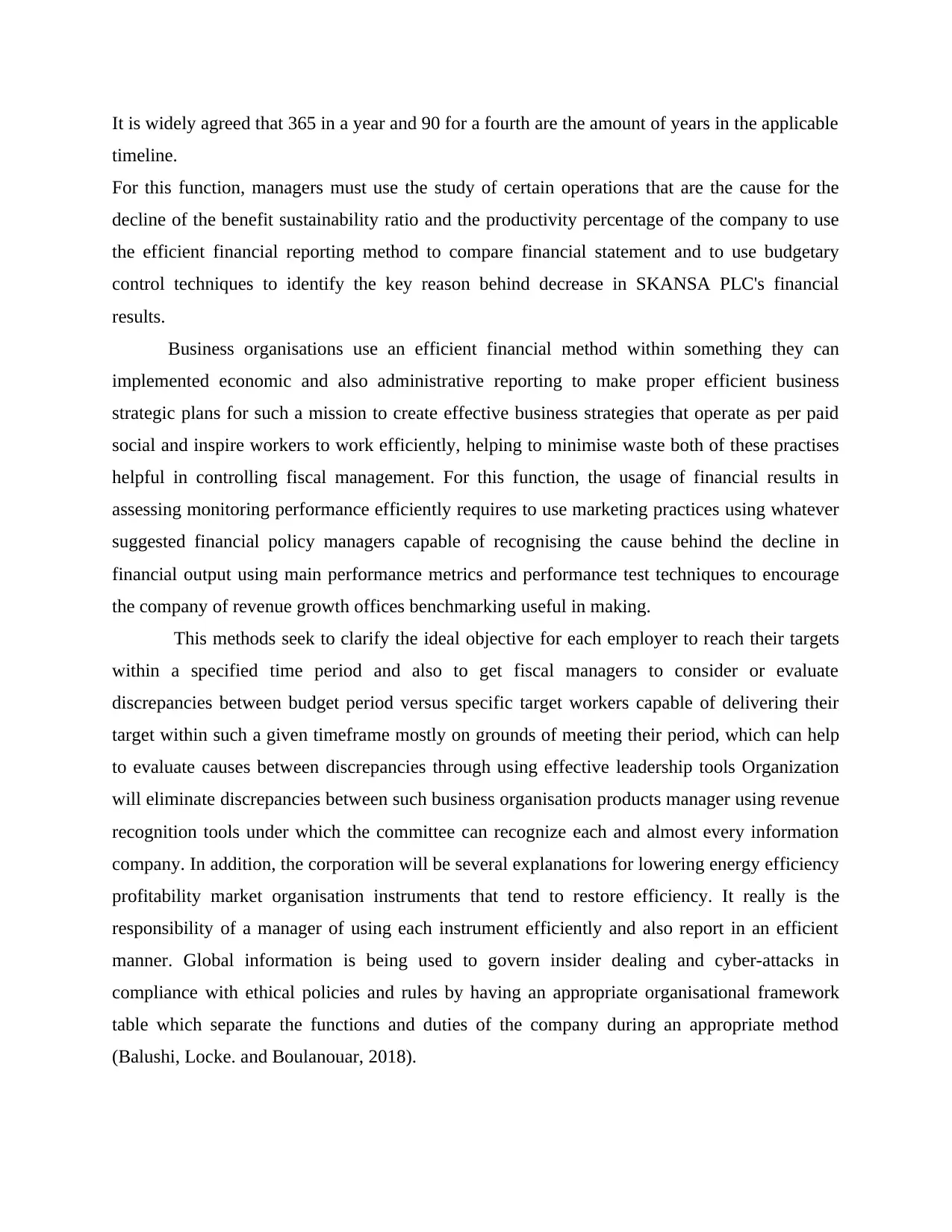
It is widely agreed that 365 in a year and 90 for a fourth are the amount of years in the applicable
timeline.
For this function, managers must use the study of certain operations that are the cause for the
decline of the benefit sustainability ratio and the productivity percentage of the company to use
the efficient financial reporting method to compare financial statement and to use budgetary
control techniques to identify the key reason behind decrease in SKANSA PLC's financial
results.
Business organisations use an efficient financial method within something they can
implemented economic and also administrative reporting to make proper efficient business
strategic plans for such a mission to create effective business strategies that operate as per paid
social and inspire workers to work efficiently, helping to minimise waste both of these practises
helpful in controlling fiscal management. For this function, the usage of financial results in
assessing monitoring performance efficiently requires to use marketing practices using whatever
suggested financial policy managers capable of recognising the cause behind the decline in
financial output using main performance metrics and performance test techniques to encourage
the company of revenue growth offices benchmarking useful in making.
This methods seek to clarify the ideal objective for each employer to reach their targets
within a specified time period and also to get fiscal managers to consider or evaluate
discrepancies between budget period versus specific target workers capable of delivering their
target within such a given timeframe mostly on grounds of meeting their period, which can help
to evaluate causes between discrepancies through using effective leadership tools Organization
will eliminate discrepancies between such business organisation products manager using revenue
recognition tools under which the committee can recognize each and almost every information
company. In addition, the corporation will be several explanations for lowering energy efficiency
profitability market organisation instruments that tend to restore efficiency. It really is the
responsibility of a manager of using each instrument efficiently and also report in an efficient
manner. Global information is being used to govern insider dealing and cyber-attacks in
compliance with ethical policies and rules by having an appropriate organisational framework
table which separate the functions and duties of the company during an appropriate method
(Balushi, Locke. and Boulanouar, 2018).
timeline.
For this function, managers must use the study of certain operations that are the cause for the
decline of the benefit sustainability ratio and the productivity percentage of the company to use
the efficient financial reporting method to compare financial statement and to use budgetary
control techniques to identify the key reason behind decrease in SKANSA PLC's financial
results.
Business organisations use an efficient financial method within something they can
implemented economic and also administrative reporting to make proper efficient business
strategic plans for such a mission to create effective business strategies that operate as per paid
social and inspire workers to work efficiently, helping to minimise waste both of these practises
helpful in controlling fiscal management. For this function, the usage of financial results in
assessing monitoring performance efficiently requires to use marketing practices using whatever
suggested financial policy managers capable of recognising the cause behind the decline in
financial output using main performance metrics and performance test techniques to encourage
the company of revenue growth offices benchmarking useful in making.
This methods seek to clarify the ideal objective for each employer to reach their targets
within a specified time period and also to get fiscal managers to consider or evaluate
discrepancies between budget period versus specific target workers capable of delivering their
target within such a given timeframe mostly on grounds of meeting their period, which can help
to evaluate causes between discrepancies through using effective leadership tools Organization
will eliminate discrepancies between such business organisation products manager using revenue
recognition tools under which the committee can recognize each and almost every information
company. In addition, the corporation will be several explanations for lowering energy efficiency
profitability market organisation instruments that tend to restore efficiency. It really is the
responsibility of a manager of using each instrument efficiently and also report in an efficient
manner. Global information is being used to govern insider dealing and cyber-attacks in
compliance with ethical policies and rules by having an appropriate organisational framework
table which separate the functions and duties of the company during an appropriate method
(Balushi, Locke. and Boulanouar, 2018).
Paraphrase This Document
Need a fresh take? Get an instant paraphrase of this document with our AI Paraphraser
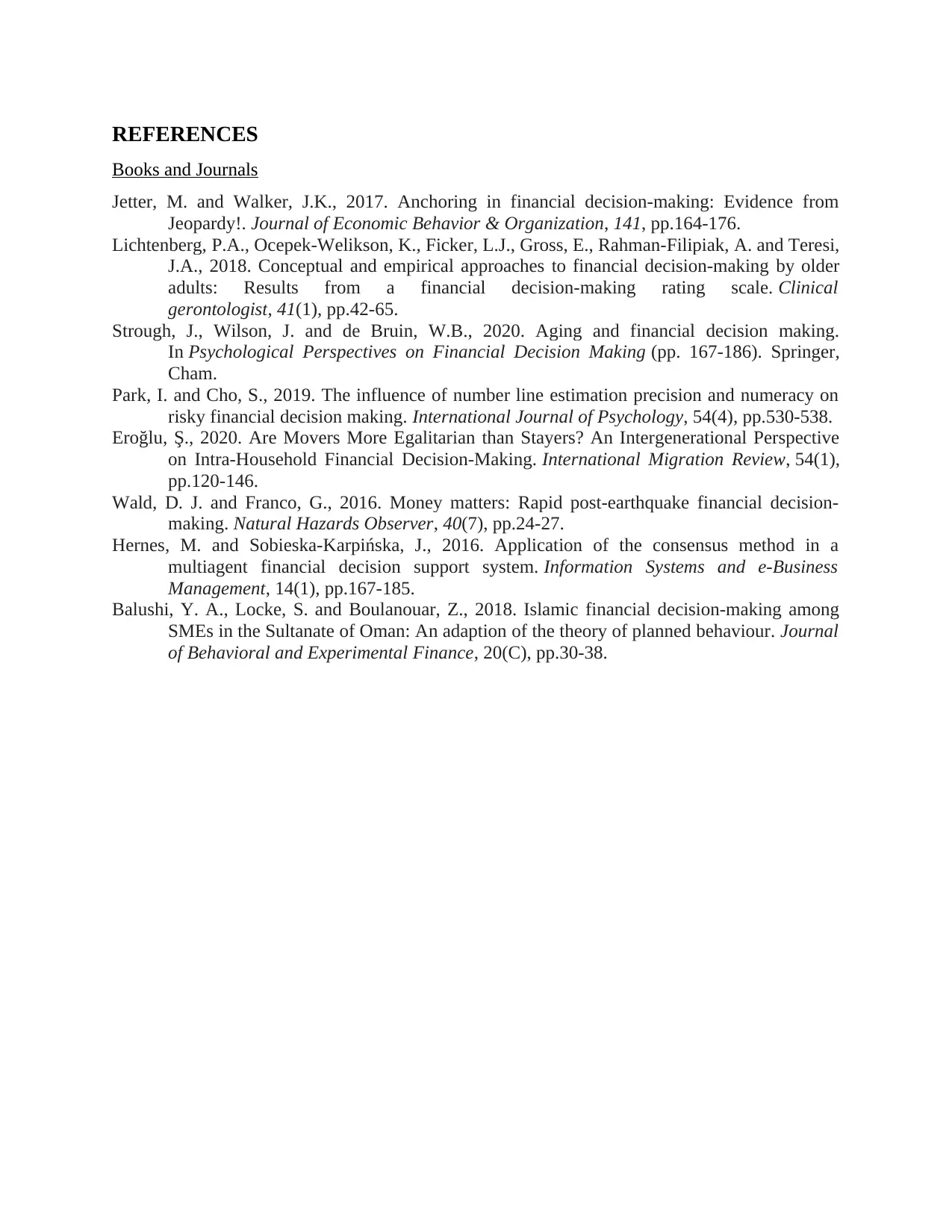
REFERENCES
Books and Journals
Jetter, M. and Walker, J.K., 2017. Anchoring in financial decision-making: Evidence from
Jeopardy!. Journal of Economic Behavior & Organization, 141, pp.164-176.
Lichtenberg, P.A., Ocepek-Welikson, K., Ficker, L.J., Gross, E., Rahman-Filipiak, A. and Teresi,
J.A., 2018. Conceptual and empirical approaches to financial decision-making by older
adults: Results from a financial decision-making rating scale. Clinical
gerontologist, 41(1), pp.42-65.
Strough, J., Wilson, J. and de Bruin, W.B., 2020. Aging and financial decision making.
In Psychological Perspectives on Financial Decision Making (pp. 167-186). Springer,
Cham.
Park, I. and Cho, S., 2019. The influence of number line estimation precision and numeracy on
risky financial decision making. International Journal of Psychology, 54(4), pp.530-538.
Eroğlu, Ş., 2020. Are Movers More Egalitarian than Stayers? An Intergenerational Perspective
on Intra-Household Financial Decision-Making. International Migration Review, 54(1),
pp.120-146.
Wald, D. J. and Franco, G., 2016. Money matters: Rapid post-earthquake financial decision-
making. Natural Hazards Observer, 40(7), pp.24-27.
Hernes, M. and Sobieska-Karpińska, J., 2016. Application of the consensus method in a
multiagent financial decision support system. Information Systems and e-Business
Management, 14(1), pp.167-185.
Balushi, Y. A., Locke, S. and Boulanouar, Z., 2018. Islamic financial decision-making among
SMEs in the Sultanate of Oman: An adaption of the theory of planned behaviour. Journal
of Behavioral and Experimental Finance, 20(C), pp.30-38.
Books and Journals
Jetter, M. and Walker, J.K., 2017. Anchoring in financial decision-making: Evidence from
Jeopardy!. Journal of Economic Behavior & Organization, 141, pp.164-176.
Lichtenberg, P.A., Ocepek-Welikson, K., Ficker, L.J., Gross, E., Rahman-Filipiak, A. and Teresi,
J.A., 2018. Conceptual and empirical approaches to financial decision-making by older
adults: Results from a financial decision-making rating scale. Clinical
gerontologist, 41(1), pp.42-65.
Strough, J., Wilson, J. and de Bruin, W.B., 2020. Aging and financial decision making.
In Psychological Perspectives on Financial Decision Making (pp. 167-186). Springer,
Cham.
Park, I. and Cho, S., 2019. The influence of number line estimation precision and numeracy on
risky financial decision making. International Journal of Psychology, 54(4), pp.530-538.
Eroğlu, Ş., 2020. Are Movers More Egalitarian than Stayers? An Intergenerational Perspective
on Intra-Household Financial Decision-Making. International Migration Review, 54(1),
pp.120-146.
Wald, D. J. and Franco, G., 2016. Money matters: Rapid post-earthquake financial decision-
making. Natural Hazards Observer, 40(7), pp.24-27.
Hernes, M. and Sobieska-Karpińska, J., 2016. Application of the consensus method in a
multiagent financial decision support system. Information Systems and e-Business
Management, 14(1), pp.167-185.
Balushi, Y. A., Locke, S. and Boulanouar, Z., 2018. Islamic financial decision-making among
SMEs in the Sultanate of Oman: An adaption of the theory of planned behaviour. Journal
of Behavioral and Experimental Finance, 20(C), pp.30-38.
1 out of 11
Related Documents
Your All-in-One AI-Powered Toolkit for Academic Success.
+13062052269
info@desklib.com
Available 24*7 on WhatsApp / Email
![[object Object]](/_next/static/media/star-bottom.7253800d.svg)
Unlock your academic potential
Copyright © 2020–2025 A2Z Services. All Rights Reserved. Developed and managed by ZUCOL.




